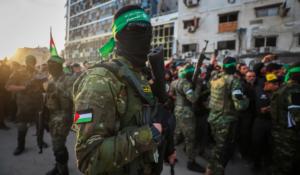Hamas’ display of force during the Gaza ceasefire shows it doesn’t plan on going anywhere

Hamas militants in Gaza on 19 January 2025
Jack Khoury writes in Haaretz on 21 January 2025:
Despite the cease-fire which went into effect two days ago, Hamas faces many challenges to its continued rule of Gaza. But if anyone was wondering whether after 15 months of a devastating war, Hamas still seeks to administer Gaza, or to at least be the dominant group there, they got their answer on Sunday.
As soon as the cease-fire was announced, security personnel and police officers in blue uniforms appeared along several of the main routes in the wrecked cities of Gaza. Soon afterward, they were joined by convoys of forces from the Hamas military wing.
They were most prominently present in Saraya Square in the heart of Gaza City during the transfer of hostages Romi Gonen, Emily Damari and Doron Steinbrecher to the Red Cross.
Hamas said their purpose was “to prevent a power vacuum and chaos, to ensure public order despite the devastation all over.” On Monday, 24 hours after the cease-fire began, the police deployment had expanded, and Hamas militants also resurfaced. Such scenes make Israel’s promises of toppling Hamas after the deal appear detached from reality. “There is no question that, as an organization, Hamas suffered a severe blow. But that doesn’t mean that it has disappeared or lost its ability to rule [Gaza],” a Hamas official told Haaretz.
He also says that the Palestinians view Hamas as a popular grassroots movement and that in every public opinion survey, it ranks first or second among the Palestinian public.
In addition to the Hamas military wing and its police force, there are another 50,000 bureaucrats in Gaza who depend on the Hamas regime. “They don’t need rockets and missiles to rule,” the official says, and adds that Hamas has no intention of fully ceding control.
Therefore, Hamas was quick to agree to the Egyptian proposal to establish a professional administrative committee in tandem with the Palestinian Authority. The proposal was rejected both by Israel and by the Palestinian Authority.
Even Hamas supporters in Gaza admit that the group owes the civilian population some answers, now that more than a million Gazans have been left homeless. Hamas will have to deal with the acute need for food, housing and medical services. Then there is also the vast rebuilding that must be done – basic infrastructure like water electricity, hospitals and schools has to be restored from the ground up.
“Total rehabilitation is needed everywhere you go,” says a Gaza City resident who evacuated to Deir al-Balah and now wishes to return home. “We’re not concerned with our political future or with some [future] plan.” “What concerns us are the most basic things: personal safety, not dying from bombardments and not to be caught up in internal chaos. We need a roof over our heads or a tent, food and basic medical aid.”
As of now, it doesn’t appear that Hamas has any viable plans for rebuilding Gaza, and it’s unclear how it will obtain the tens of billions of dollars that will be needed for such a massive-scale rehabilitation. However, no one else seems to have any real framework for restoration – certainly not the Palestinian Authority. PA officials say that Hamas has a clear advantage over them, and over any other agency in Gaza, since they are the organization currently on the ground.
“The PA submitted a plan and says it is ready to rule in Gaza – but there’s no feasibility. Israel is in control and has not yet expressed any willingness to incorporate the PA.”
“Instead, it is planning operations in the West Bank,” the officials says. They also say that the international community, including the Arab nations, are making their participation in the rebuilding process contingent upon extensive reforms in the PA, which Abbas has not agreed to. “There’s a difference between plans on paper and a serious political desire to bring about change,” says one PA official.
Now people in Gaza are waiting to see if the deal will be implemented in full, if the fighting really does not resume and if the rate of humanitarian aid entering Gaza truly increases in the coming days.
International organizations will be given responsibility for distributing aid, including tents and trailers as temporary solutions for those who lost their homes in the fighting. Long-term solutions are yet to be determined.
Israel rejects any plans for either Hamas or the PA to administer Gaza, but its options are limited: One, the establishment of a Palestinian national unity government that would bring new figures to the scene, instead of figures like current PA Prime Minister Mohammed Mustafa. Option two is to enable Hamas to keep controlling Gaza. Option three is to resume the war.
Another possibility is to have Egypt or Qatar send subcontractors at their expense to conduct the rehabilitation efforts. Other countries could also participate in this model, with the Gaza Strip being divided into project “zones” that would not be subject to one central government. This might significantly delay the rebuilding process, and is similar to what was done after the 2014 Gaza War and the ensuing operation in 2021.
The PA will not agree to such a proposal, but it may not be able to oppose it from its weakened position. Even if the war has really come to an end, the road to rebuild Gaza will still be long and weary.
This article is reproduced in its entirety
